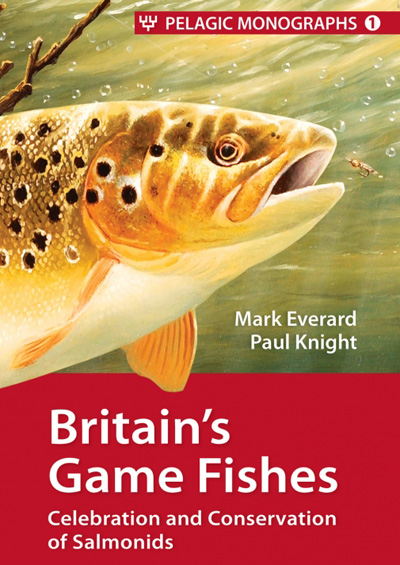Apart from my regular winter grayling fishing and very occasional (and very haphazard) attempts to persuade something spotty to take a bit of fluff or feather I am not a game angler and so am not, perhaps, at first glance at least, the ideal reviewer for a book on Britain’s Game Fishes.
I did consider passing it to a game fishing colleague for comment but after some thought decided that as a fishery biologist and non game angler I was possibly the more appropriate person; particularly as the book is about the fish species themselves, as opposed to angling for them and, ultimately, it serves to highlight the importance of the salmonids to wider society and to those who would eat them and conserve them as much as to those who choose simply just to fish for them!
 As far as the book is concerned it is split into three distinct sections. The first giving a natural history of our native salmonids (and one non-native in the case of the rainbow trout), the second examining the many threats facing them and the third, an extension of the second, looking at what the future holds for them.
As far as the book is concerned it is split into three distinct sections. The first giving a natural history of our native salmonids (and one non-native in the case of the rainbow trout), the second examining the many threats facing them and the third, an extension of the second, looking at what the future holds for them.
The natural history lessons are concise and, whilst undoubtedly useful for occasional or non anglers, will, I suspect, bring little new to the table for most except by means of reference. That said there are some fascinating nuggets to be found and I was particularly interested in the short chapter on the whitefishes, or coregonids, (vendace, powan) a subfamily of which I was aware but about which I knew very little. I still don’t know much – it is a short chapter – but it was nevertheless interesting!
It was only once the book moved onto the pressures that the salmonid species face that I really became fully engaged with it. Land use changes, abstraction, pollution, climate change, netting, fish farming etc are known to most and all of these aspects, and more, are examined in fascinating detail from both an historical and current context. It is not a happy picture the authors paint, but it is not all doom and gloom either as various strategies for minimising, or eradicating, the threats are discussed and the final section goes on to show some of the real progress that has been made, and can be made, going forward.
The final thoughts you are left with when you put the book down is of a vitally important fish family in dire straits (probably more dire that you imagined) but there is enough optimism to make you realise that all is not yet lost and, I suspect, although it is a factual book delivered in an intelligent and studious style there is enough real passion delivered by the authors to make you want to get off your backside and help to do something about it!
The Authors
Dr Mark Everard will be well known to most FM readers and has had a lifelong obsession with fish, water and the aquatic environment. Author of numerous books, magazine and scientific publications, many of them addressing fish and fishing, he is also a regular contributor to TV and radio. He is an adviser to government in the UK, India and South Africa on the sustainable use and management of water and other ecosystems, having also advised and conducted research right across the world.
Mark is science adviser to the Salmon & Trout Association (S&TA) as well as vice-president of the Institution of Environmental Sciences (IES), fellow of the Linnean Society, founding director of the Bristol Avon Rivers Trust (BART), and a life member and former council member of both the Freshwater Biological Association (FBA) and the Angling Trust.
Paul Knight has been involved with fish for most of his working life, including catching them as a commercial fi sherman and angler, growing themas a trout farmer and now trying to conserve them as Chief Executive of the Salmon & Trout Association (S&TA). He is a Council member and Fellow of the Institute of Fisheries Management (IFM), and spends his time attempting to innfluence government departments and agencies to follow
policies that will protect the aquatic environment and all its dependent species.
I spoke with Mark before reading the book and he commented:
“Many anglers may know Paul Knight and me primarily through our various angling exploits. However, we are also both deeply involved in river and fishery conservation, and I am an active scientist and international government adviser. It is this breadth of experience and insight that we bring to bear on Britain’s Game Fishes. The subtitle ‘Celebration and Conservation of Salmonids’ sums up our approach. We kick off by describing all the native salmonids as well as the odd interloper (the American rainbow trout!), turning then to the multiple problems they face and concluding with positive conservation success stories. This book is aimed at anglers, conservationists and anyone else with an enquiring mind about rivers and larger stillwaters who wants to understand more about these fascinating fishes and what can be done to protect them for the future.”
Britain’s game Fishes runs to 240 pages, is published by Pelagic Publishing and is available from all good bookshops at £24.99. Alternatively it may be ordered direct from Pelagic Publishing
A sample chapter may be read online HERE













